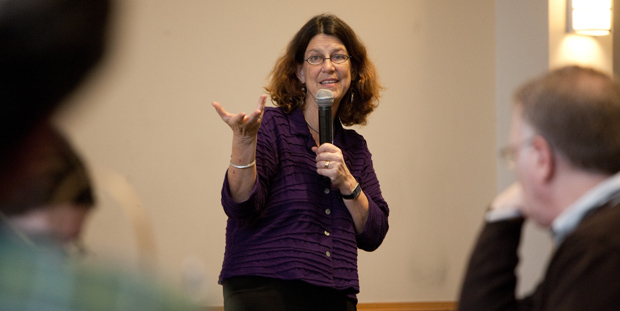Kathy Schultz: Teachers should rethink meaning of student silence
They may be reflecting, resisting, or just waiting for a reason to speak

Author and Mills College Dean of Education Kathy Schultz at the fifth annual Teacher Forum.
There are many ways to think about student silence in classrooms, but all should include an understanding that silence is a form of participation, said Schultz, the author of “Rethinking Student Participation: Listening to Silent Voices.” She spoke at the fifth annual Teacher Forum, a workshop for Jewish and general educators sponsored by the Mandel Center for Studies in Jewish Education.
Instead of rewarding speech and penalizing silence, Schultz urged teachers to think in a more nuanced way about how students participate in class. Silent students may be taking time to pause and reflect, may be resisting what they are hearing, may be using silence as way to feel more in control or might just be waiting for a reason to speak.
“Silence,” she said, “can give some students time and space for their learning. What would an inquiry stance toward student silence look like? What conditions engender speech or silence for a particular child? We don’t always know which moments are most authentic or important to our students.”
Schultz pointed out that teachers may identify student silence as a problem because they are uncomfortable with it. But some students may come from cultures in which silence is a form of respect or deference, or they may be having trouble at home — another reason why it is important for teachers to understand students’ sociocultural backgrounds and family situations.
“Think of silence as a container that can hold all sorts of things,” Schultz said. “This gives us new ways to understand classroom interactions and how silence and speech are interconnected.”
After Schultz’s presentation, teachers worked together to help one another think more broadly about silence and speech in their classrooms.
Keeping in mind Schultz’s suggestion that they consider “engaged participation, rather than speaking or not speaking,” they discussed individual students and brainstormed strategies for helping them participate in class in ways that will support their own learning and their classmates’.
“All too often,” Schultz said, “discussions about silence become discussions about getting kids to talk." She suggested that silence can be used by teachers as an intentional strategy to encourage more reflective participation.
Categories: Humanities and Social Sciences





